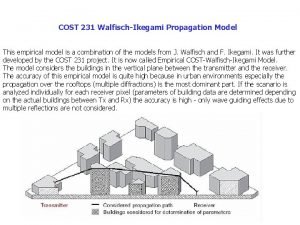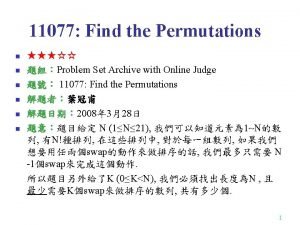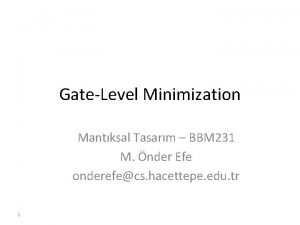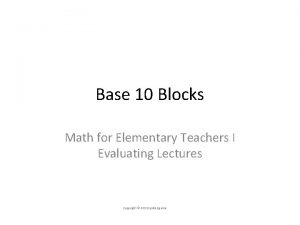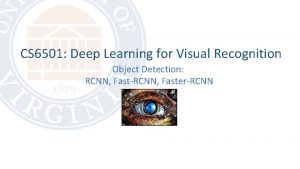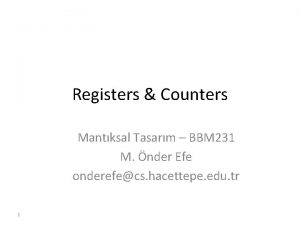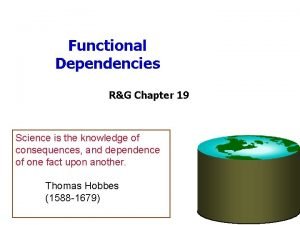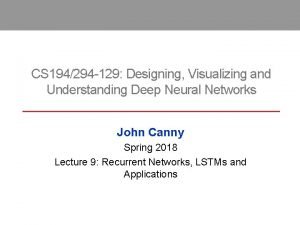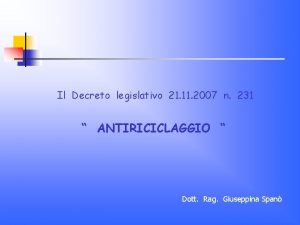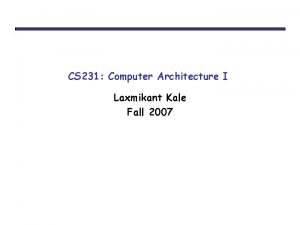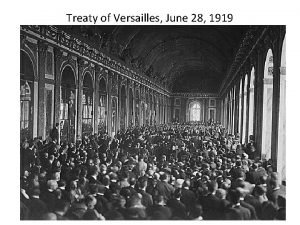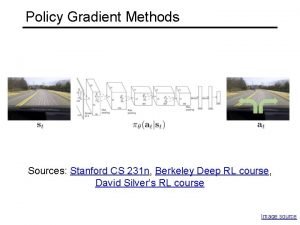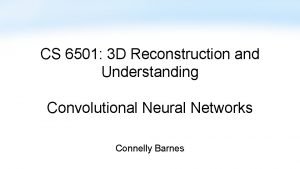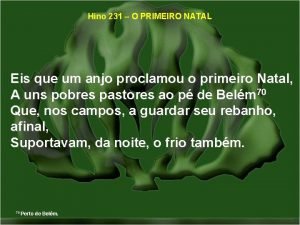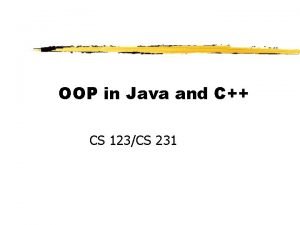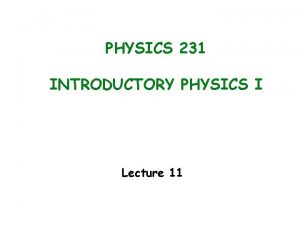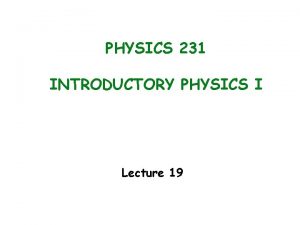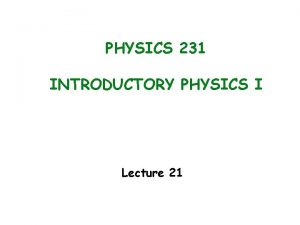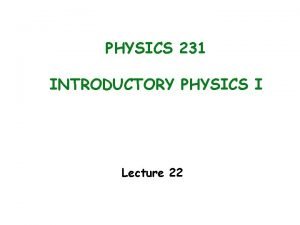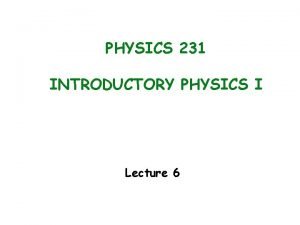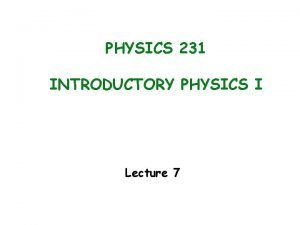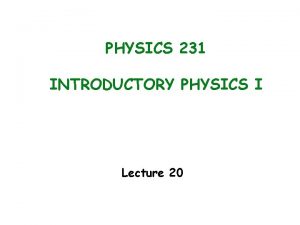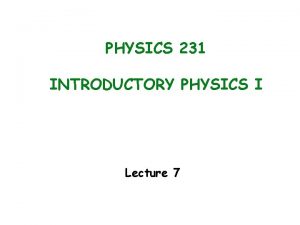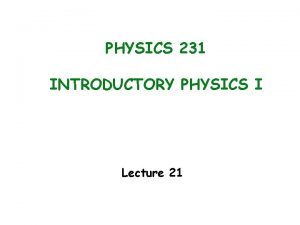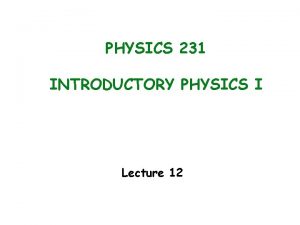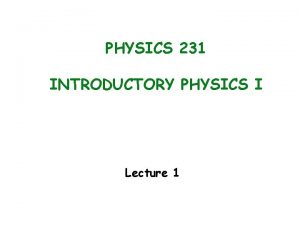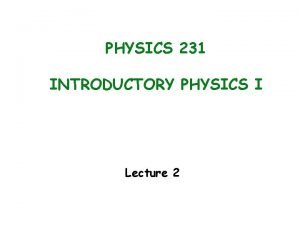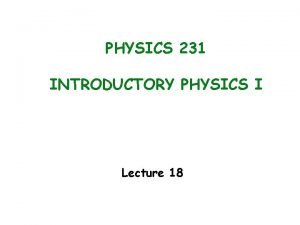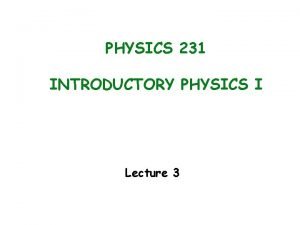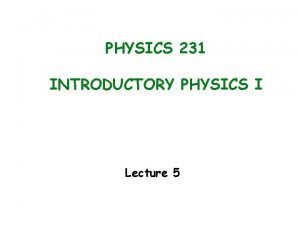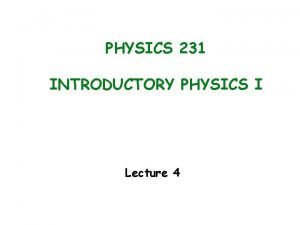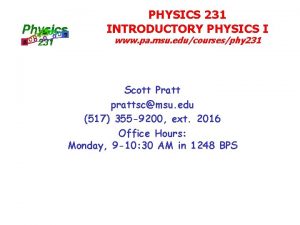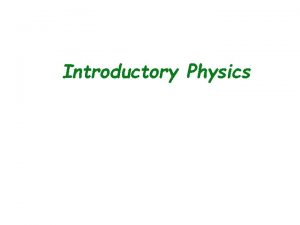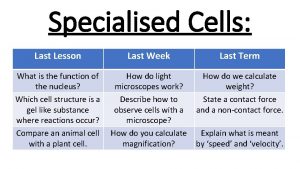PHYSICS 231 INTRODUCTORY PHYSICS I Lecture 23 Last






























- Slides: 30

PHYSICS 231 INTRODUCTORY PHYSICS I Lecture 23

Last Lecture -Sound • Speed of sound in fluid (for solid, replace • Intensity Level - d. B • Spherical Waves )

Doppler Effect, Moving Observer Towards source: Away from source: v = speed of sound, v. O = speed of observer

Doppler Effect: Source in Motion

Doppler Effect, Source in Motion Approaching source: Source leaving:

Example 14. 6 An train has a brass band playing a song on a flatcar. As the train approaches the station at 21. 4 m/s, a person on the platform hears a trumpet play a note at 3520 Hz. DATA: vsound = 343 m/s a) What is the true frequency of the trumpet? a) 3300 Hz b) What is the wavelength of the sound? b) 9. 74 cm c) If the trumpet plays the same note after passing the platform, what frequency would the person on the platform hear? c) 3106 Hz

Shock Waves (Sonic Booms) When the source velocity exceeds the speed of sound,

Application: speed radar

Application: weather radar Both humidity (reflected intensity) and speed of clouds (doppler effect) are measured.

Doppler Effect: Both Observer and Source Moving Switch appropriate signs if observer or source moves away

Example 14. 7 At rest, a car’s horn sounds the note A (440 Hz). The horn is sounded while the car moves down the street. A bicyclist moving in the same direction at 10 m/s hears a frequency of 415 Hz. DATA: vsound = 343 m/s. What is the speed of the car? (Assume the cyclist is behind the car) 31. 3 m/s

Example 14. 8 a A train has a whistle with a frequency of a 1000 Hz, as measured when both the train and observer are stationary. For a train moving in the positive x direction, which observer hears the highest frequency when the train is at position x=0? Observer A B C D has has velocity VA>0 and has position XA>0. VB>0 and has position XB<0. VC<0 and has position XC>0. VD<0 and has position XD<0.

Example 14. 8 b A train has a whistle with a frequency of a 1000 Hz, as measured when both the train and observer are stationary. A train is moving in the positive x direction. When the train is at position x=0, An observer with V>0 and position X>0 hears a frequency: a) > 1000 Hz b) < 1000 Hz c) Can not be determined

Example 14. 8 c A train has a whistle with a frequency of a 1000 Hz, as measured when both the train and observer are stationary. A train is moving in the positive x direction. When the train is at position x=0, An observer with V>0 and position X<0 hears a frequency: a) > 1000 Hz b) < 1000 Hz c) Can not be determined

Example 14. 8 d A train has a whistle with a frequency of a 1000 Hz, as measured when both the train and observer are stationary. A train is moving in the positive x direction. When the train is at position x=0, An observer with V<0 and position X<0 hears a frequency: a) > 1000 Hz b) < 1000 Hz c) Can not be determined

Standing Waves Consider a wave and its reflection:

Standing Waves • Factorizes into x-piece and t-piece • Always ZERO at x=0 or x=ml/2

Resonances Integral number of half wavelengths in length L

Nodes and anti-nodes • A node is a minimum in the pattern • An antinode is a maximum

Fundamental, 2 nd, 3 rd. . . Harmonics 2 nd harmonic 3 rd harmonic Fundamental (n=1)

Example 14. 9 A cello string vibrates in its fundamental mode with a frequency of 220 vibrations/s. The vibrating segment is 70. 0 cm long and has a mass of 1. 20 g. a) Find the tension in the string a) 163 N b) Determine the frequency of the string when it vibrates in three segments. b) 660 Hz

Beats Interference from two waves with slightly different frequency

Beat Frequency Derivation After time Tbeat, two sounds will differ by one complete cycle.

Beats Demo

Standing waves in Pipes - Open both ends Same expression for closed at both ends

Standing waves in Pipes - Closed one end

Example 14. 10 An organ pipe of length 1. 5 m is open at one end. What are the lowest two harmonic frequencies? DATA: Speed of sound = 343 m/s 57. 2 Hz, 171. 5 Hz

Example 14. 11 An organ pipe (open at one end and closed at the other) is designed to have a fundamental frequency of 440 Hz. Assuming the speed of sound is 343 m/s, a) What is the length of the pipe? a) 19. 5 cm b) What is the frequency of the next harmonic? b) 1320 Hz

Interference of Sound Waves Assume sources “a” and “b” are “coherent”. If observer is located ra and rb from the two sources, Source a Source b rb ra Observer

Example 14. 12 A pair of speakers separated by 1. 75 m are driven by the same oscillator at a frequency of 686 Hz. An observer starts at one of the speakers and walks on a path that is perpendicular to the separation of the two speakers. (Assume vsound = 343 m/s) a) What is the position of the last intensity maximum? a) 2. 81 m b) What is the position of the last intensity minimum? b) 6. 00 m c) What is the position of the first intensity maximum? c) 27 cm
 01:640:244 lecture notes - lecture 15: plat, idah, farad
01:640:244 lecture notes - lecture 15: plat, idah, farad Randy pausch last lecture summary
Randy pausch last lecture summary Cost 231 model
Cost 231 model Cs 231 n
Cs 231 n 123+132+321+312
123+132+321+312 Bbm 231
Bbm 231 Gezang 231
Gezang 231 Toastmasters timer sheet
Toastmasters timer sheet Draw 231 with base ten blocks
Draw 231 with base ten blocks Cs 231 n
Cs 231 n Pa msu
Pa msu Pengertian berjiran
Pengertian berjiran Bbm231
Bbm231 Acf 231
Acf 231 Definition of potential gradient
Definition of potential gradient 040 231 3666
040 231 3666 Visualizing and understanding recurrent networks
Visualizing and understanding recurrent networks 231 del 2007
231 del 2007 German territorial losses ww1
German territorial losses ww1 Cs 231
Cs 231 Potential gradient
Potential gradient Article 231 of the treaty of versailles
Article 231 of the treaty of versailles 231n stanford
231n stanford Mvcnn pytorch
Mvcnn pytorch Cs 231 n
Cs 231 n Hino 231 novo cantico
Hino 231 novo cantico Java 231
Java 231 Physics 101 lecture notes pdf
Physics 101 lecture notes pdf Physics 111 lecture notes
Physics 111 lecture notes Waves pdf
Waves pdf Physics 101 lecture
Physics 101 lecture


